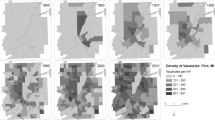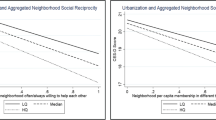Abstract
We sought to apply social disorganization/social capital theory to the prediction of larceny victimization among community-dwelling residents. Based on social disorganization theory, we empirically derived an index of “social distance” by calculating averaged differences in sociodemographic characteristics (social class, stage of life course, size of hometown of origin) between residents. Our study was based on a postal questionnaire mailed to 1,000 residents of Arakawa Ward, Tokyo, Japan. Based on social capital theory, we also tested if neighborhood-level social ties could buffer the association between social distance and larceny victimization. Using multilevel analyses, we found that higher neighborhood-level social distance was associated with increased larceny victimization, independently of the respondents’ own background sociodemographic characteristics. Additionally, area-level supportive networks buffered the adverse effect of social distance on larceny victimization. By contrast, we also found that network size magnified the probability of victimization in neighborhoods characterized by large social distances between residents.


Similar content being viewed by others
References
Barabasi, A. L. (2002). Linked: the new science of networks. Cambridge: Perseus Book Group.
Bellair, P. E. (1997). Social interaction and community crime: examining the importance of neighbor networks. Criminology, 35, 677–704.
Bellair, P. E. (2000). Informal surveillance and street crime: a complex relationship. Criminology, 38, 137–167.
Bourdieu, P. (1984). Distinction: a social critique of the judgment of taste. Cambridge: Harvard University Press.
Bursik, R. J., & Grasmick, H. (1995). Neighborhoods and crime: the dimensions of effective community control. New York: Lexington Books.
Cohen, J., Cohen, P., West, S. G., & Aiken, L. S. (2003). Applied multiple regression/correlation analysis for the behavioral sciences. Mahwah: Erlbaum.
Elder, G. H. (1999). Children of the great depression: social change in life experience. Boulder: Westview Press.
Fischer, C. S. (1982). Two dwell among friends: personal networks in town and city. Chicago: University of Chicago Press.
Granovetter, M. (1973). The strength of weak ties. American Journal of Sociology, 78, 1360–1380.
Green, D. P., Strolovitch, D. Z., & Wong, J. S. (1998). Defended neighborhoods, integration, and racially motivated crime. American Journal of Sociology, 104, 372–403.
Hipp, J. R. (2007). Income inequality, race, and place: does the distribution of race and class within neighborhoods affect crime rates? Criminology, 45, 665–697.
Hipp, J. R. (2010). Micro-structure in micro-neighborhoods: a new social distance measure, and its effect on individual and aggregated perceptions of crime and disorder. Social Networks, 32, 148–159.
Hipp, J. R., & Perrin, A. J. (2009). The simultaneous effect of social distance and physical distance on the formation of neighborhood ties. City & Community, 8, 5–25.
Kennedy, B. P., Kawachi, I., Prothrow-Stith, D., Lochner, K., & Gupta, V. (1998). Social capital, income inequality, and firearm violent crime. Social Science and Medicine, 47, 7–17.
Kuramitsu, T. (2008). Widening gap and its countermeasure in Japanese society. Journal of Economic Policy Studies, Kagawa University, 4, 23–47 (in Japanese).
Lederman, D., Loayza, N., & Menendez, A. M. (2002). Violent crime: does social capital matter? Economic Development and Cultural Change, 50, 509–539.
Martin, D. (2002). Spatial patterns in residential burglary: assessing the effect of neighborhood social capital. Journal of Contemporary Criminal Justice, 18, 132–146.
Massey, D. S., & Denton, N. A. (1987). Trends in the residential segregation of Blacks, Hispanics, and Asians: 1970–1980. American Sociological Review, 52, 802–825.
McCulloch, A. (2003). An examination of social capital and social disorganization in neighborhoods in the British household panel study. Social Science & Medicine, 56, 1425–1438.
Messner, S. F., Baumer, E. P., & Rosenfeld, R. (2004). Dimensions of social capital and rates of criminal homicide. American Sociological Review, 69, 882–903.
Mizoguchi, T. (1992). Contemporary problems of statistical survey in Japan. Tokyo: Iwanami Shoten (in Japanese).
Morenoff, J. D., Sampson, R. J., & Raudenbush, S. W. (2001). Neighborhood inequality, collective efficacy, and the spatial dynamics of urban violence. Criminology, 39, 517–559.
Otake, F. (2005). Inequality in Japan: dreams and future of unequal society. Tokyo: Nihon Keizai Shinbun (in Japanese).
Park, W. (1993a). Trends of the crime rate in the postwar Japan: a time-series regression approach (1). Hougaku Shinpou, 99, 165–230 (in Japanese).
Park, W. (1993b). Trends of the crime rate in the postwar Japan: a time-series regression approach (2). Hougaku Shinpou, 99, 221–266 (in Japanese).
Park, W. (1994). Trends of the crime rate in the postwar Japan: a time-series regression approach (3). Hougaku Shinpou, 99, 169–195 (in Japanese).
Patacchini, E., & Zenou, Y. (2008). The strength of weak ties in crime. European Economic Review, 52, 209–236.
Putnam, R. D. (1995). Bowling alone: America’s declining social capital. Journal of Democracy, 6, 65–78.
Putnam, R. D. (2000). Bowling alone: the collapse and revival of American community. New York: Simon & Schuster.
Rose, D. R., & Clear, T. R. (1998). Incarceration, social capital, and crime: implications for social disorganization theory. Criminology, 36, 441–479.
Rosenfeld, R., Messner, S. F., & Baumer, E. P. (2001). Social capital and homicide. Social Forces, 80, 283–309.
Ross, C. E., & Jang, S. J. (2000). Neighborhood disorder, fear, and mistrust: the buffering role of social ties with neighbors. American Journal of Community Psychology, 28, 401–420.
Rountree, P. W., & Warner, B. D. (1999). Social ties and crime: is the relationship gendered? Criminology, 37, 789–814.
Sampson, R. J. (1984). Group size, heterogeneity, and intergroup conflict: a test of Blau’s inequality and heterogeneity. Social Forces, 62, 618–639.
Sampson, R. J. (1988). Local friendship ties and community attachment in mass society: a multilevel systemic model. American Sociological Review, 53, 766–779.
Sampson, R. J. (1995). The community. In J. Q. Wilson & J. Petersilia (Eds.), Crime (pp. 193–216). San Francisco: Institute for Contemporary Studies.
Sampson, R. J., & Groves, W. B. (1989). Community structure and crime: testing social-disorganization theory. American Journal of Sociology, 94, 774–802.
Sampson, R. J., Raudenbush, S. W., & Earls, F. (1997). Neighborhoods and violent crime: a multilevel study of collective efficacy. Science, 277, 918–924.
Shaw, C., & McKay, H. (1942). Juvenile delinquency and urban areas. Chicago: University of Chicago Press.
Shigekawa, J. (1997). Features of missing values in the panel survey on consumption behavior. Research on Household Economics, 33, 76–83 (in Japanese).
Simon, B., Hastedt, C., & Aufderheide, B. (1997). When self-categorization makes sense: the role of meaningful social categorization in minority and majority members’ self-perception. Journal of Personality and Social Psychology, 73, 310–320.
Small, M. L. (2008). Unanticipated gains: origins of network inequality in everyday life. New York: Oxford University Press.
South, S. J., & Deane, G. D. (1993). Race and residential mobility: individual determinants and structural constraints. Social Forces, 72, 147–167.
Takagi, D., Tsuji, R., & Ikeda, K. (2010). Crime control by local communities: focusing on social capital and cooperative behaviors in neighborhoods. Japanese Journal of Social Psychology, 26, 36–45 (in Japanese).
Watts, D. J. (2003). Six degrees: the science of a connected age. New York: W. W. Norton.
Wirth, L. (1956a). Life in the city. In L. Wirth (Ed.), Community life and social policy (pp. 206–217). Chicago: University of Chicago Press.
Wirth, L. (1956b). Urbanism as a way of life. In P. Kasinitz (Ed.), Metropolis: center and symbol of our times (pp. 58–82). New York: New York University Press.
Acknowledgments
This research was supported by a grant received by the first author from the Japan Society for the Promotion of Science (Grant Number: DC2 22-8772).
Author information
Authors and Affiliations
Corresponding author
Rights and permissions
About this article
Cite this article
Takagi, D., Kawachi, I. Neighborhood Social Heterogeneity and Crime Victimization in Japan: Moderating Effects of Social Networks. Asian Criminology 9, 271–284 (2014). https://doi.org/10.1007/s11417-014-9191-9
Received:
Accepted:
Published:
Issue Date:
DOI: https://doi.org/10.1007/s11417-014-9191-9




